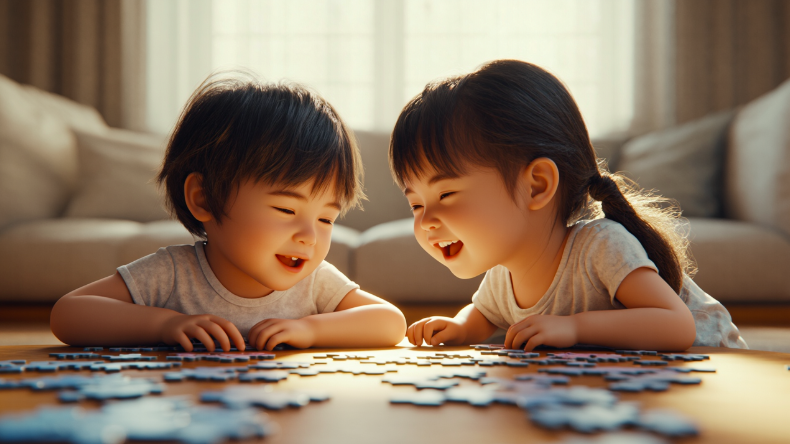Easy Assembly Puzzles For Families: Fun And Bonding Time
Discover the joy of solving easy assembly puzzles for families, enhancing teamwork, communication, and creating lasting memories together.
Mar 28, 20251K Shares80.3K Views

In today's fast-paced world, finding activities that bring families together can be challenging. One enjoyable and engaging way to spend quality time as a family is through jigsaw puzzles. These puzzles not only provide entertainment but also enhance teamwork, communication, and cognitive skills. Easy assembly puzzles are particularly beneficial as they allow family members of all ages to participate and contribute. By working together on a puzzle, families can strengthen their bonds and create lasting memories.
Jigsaw puzzles have been a staple of family activities for generations. They offer a unique opportunity for family members to collaborate, share ideas, and learn from each other. The process of assembling a puzzle requires patience, strategy, and problem-solving skills, which are essential for cognitive development. Moreover, puzzles help improve spatial reasoning and memory, making them an excellent educational tool.
Choosing the Right Puzzle for Your Family
Selecting the right puzzle for your family is crucial to ensure everyone can enjoy the experience. Here are some tips to help you choose:
Puzzle Size:
- 100 Pieces: Suitable for young children (ages 3-5) or beginners.
- 500 Pieces: Ideal for older children (ages 8-12) or adults who are casual puzzle enthusiasts.
- 1000 Pieces: Best for experienced puzzlers or families with older children and adults.
Theme and Design: Choose puzzles with themes that interest your family, such as landscapes, animals, or movies. This will keep everyone engaged and motivated.
Skill Level: Ensure the puzzle is challenging yet not frustratingly difficult. This will encourage participation and teamwork.
Strategies for Easy Assembly
Assembling a puzzle as a family can be a fun and rewarding experience if done correctly. Here are some strategies to help you:
- Start with the Edges: Begin by building the frame of the puzzle. This helps define the space and makes it easier to place other pieces.
- Sort by Color: Organize puzzle pieces by color to simplify the process and reduce confusion.
- Work on Sections: Divide the puzzle into sections and assign each family member a section to work on. This promotes teamwork and keeps everyone engaged.
- Avoid Frustration: Encourage patience and collaboration. If someone gets stuck, help them find the right piece or suggest a different approach.
Educational and Bonding Benefits
Jigsaw puzzles offer numerous educational and bonding benefits for families:
- Problem-Solving Skills: Puzzles enhance critical thinking and problem-solving abilities by requiring individuals to analyze and fit pieces together.
- Memory and Spatial Reasoning: Working on puzzles improves memory by remembering where pieces fit and enhances spatial reasoning by understanding how pieces relate to each other.
- Bonding and Teamwork: Puzzles foster collaboration and communication among family members, strengthening bonds and creating shared experiences.
- Custom Photo Puzzles: Using custom photo puzzles can make the experience more personal and engaging. It allows families to work together on a puzzle that holds sentimental value.
Making Puzzle Nights a Success
To make family puzzle nights enjoyable and successful, consider these tips:
- Dedicated Time: Set aside a specific time each week for puzzle nights to ensure everyone can participate.
- Comfortable Environment: Create a cozy and comfortable space with good lighting and minimal distractions.
- Snacks and Competitions: Incorporate snacks and small competitions to keep everyone engaged and motivated.
FAQs
1. What is the ideal age for children to start working on jigsaw puzzles?
Children can start working on jigsaw puzzles as early as 3 years old with simple puzzles. As they grow older, they can move to more complex ones. For instance, puzzles with larger pieces are suitable for younger children, while smaller pieces are better for older kids.
2. How long does it typically take to complete a family puzzle?
The time it takes to complete a puzzle depends on its size and the number of people working on it. A 100-piece puzzle might take a few hours, while a 1000-piece puzzle could take several days or weeks.
3. Can puzzles be used as an educational tool?
Yes, puzzles are excellent educational tools. They enhance problem-solving skills, memory, and spatial reasoning. They also promote teamwork and communication among family members.
4. How can I ensure that younger children stay engaged during puzzle nights?
To keep younger children engaged, use puzzles with larger pieces and colorful themes. Encourage them to work on simpler sections and offer help when needed. Make it fun by incorporating storytelling or competitions.
5. What are some ways to make puzzle nights more enjoyable for everyone?
To make puzzle nights more enjoyable, set up a cozy environment, offer snacks, and incorporate small competitions or rewards. You can also play music or have a themed night to match the puzzle's theme.
Jump to
Choosing the Right Puzzle for Your Family
Strategies for Easy Assembly
Educational and Bonding Benefits
Making Puzzle Nights a Success
FAQs
2. How long does it typically take to complete a family puzzle?
3. Can puzzles be used as an educational tool?
4. How can I ensure that younger children stay engaged during puzzle nights?
5. What are some ways to make puzzle nights more enjoyable for everyone?
Latest Articles
Popular Articles